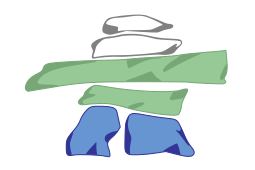Flag of Nunatsiavut facts for kids
 |
|
| Proportion | 2:3 |
|---|---|
| Adopted | 1973 |
| Design | An inuksuk coloured white, blue, and green, featured on a white field |
The flag of Nunatsiavut is a special symbol for the Inuit people of Labrador, Canada. It represents their land, which is called Nunatsiavut. This flag was chosen by the Labrador Inuit Association to show their identity and their unique area.
The flag shows a traditional Inuit inuksuk. An inuksuk is a human-made stone landmark or cairn. It is often used by Inuit people for navigation or as a marker. On the flag, the inuksuk is white, blue, and green. These colors are also found on the flag of Labrador, connecting the two symbols.
Contents
What is Nunatsiavut?
Nunatsiavut is a special area in northern Labrador. It is a self-governing region for the Inuit people. This means the Inuit have more control over their land and how it is managed. This area was created after a land claims agreement.
The Meaning of the Flag's Design
The flag's design is simple but full of meaning.
- The inuksuk is a very important symbol for the Inuit. It shows their culture, history, and connection to the land.
- The colors on the flag are also significant:
- White often represents snow and ice, which are a big part of the Arctic landscape.
- Blue can stand for the water, like the ocean and lakes, and the sky.
- Green represents the land, especially the plants and nature found in the region.
When the Flag Became Official
The flag became an official symbol for Nunatsiavut on December 1, 2005. This happened when the Labrador Inuit Constitution was formally approved. A constitution is like a rulebook for a government or a group of people. It explains how things will be run. The Nunatsiavut Constitution includes a drawing and description of the flag, making it a clear and official symbol of the region.
See also
 In Spanish: Bandera de Nunatsiavut para niños
In Spanish: Bandera de Nunatsiavut para niños

